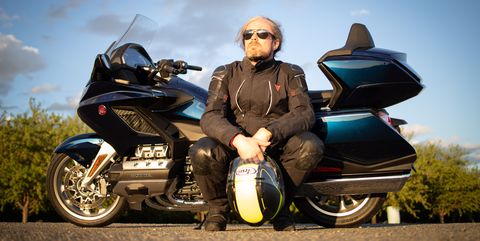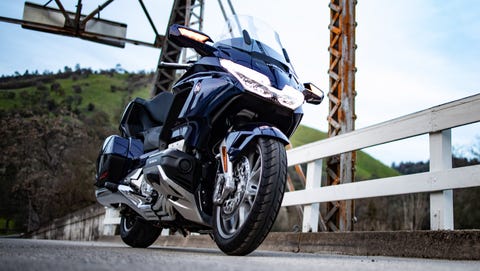Dreams on a Honda Gold Wing
Give your dreams some Gold Wings
By Davey G. Johnson

As the 1960s gave way to the '70s, a machine called the M1 sprung to life in Honda's R&D department. The company was hardly a stranger to motorcycles with more than four cylinders, having demolished the competition during the 1966 Grand Prix season with the inline-six-powered 250-cc RC166, still one of the most glorious-sounding internal-combustion machines ever to see duty on land, in the sea, or in the air. But the M1 was a horse of a different wheelbase.
Like BMWs and Moto Guzzis of the era, the M1 was shaft driven, with a crankshaft running parallel to the bike's track. Unlike the German and Italian twins, three cylinders per side transmogrified combustion into motive force. In 1975, the M1 begat a hefty, sport-oriented, unfaired bike called the GL1000 Gold Wing, carrying a 1.0-liter pancake four instead of the complex flat-six. By the end of '83, those 999 cubic centimeters had grown to 1182. Two generations and a decade into its existence, the GL1200 was practically unrecognizable in comparison to the first Wing, available only with a full fairing, ample side cases, and a top trunk with a plush integrated passenger backrest. Despite its sporty origins, the touring market had claimed the Wing for its own.
None of this history mattered to me as a kid in the back of my grandparents' station wagon during our trips to California's northeasterly coastal regions during the mid-1980s. All I knew is that the couples on those Gold Wings, often wearing an "Aspencade" heckblende across the trunk, were without doubt the royalty of the American highway.

Almost four years ago, a month before I was clipped by an inattentive motorist on my Moto Guzzi V7, I borrowed a previous-generation Gold Wing, a variant then known as the F6B. The F6B dispensed with the full-boat Wing's top trunk, occupying the space in the line now held by the base Gold Wing. I took the long way from Honda HQ in Torrance out to Ann Arbor, and after the freeway blast from Los Angeles up to Idaho, discovered the machine's sporting heart on the mountain roads between Idaho Falls and Jackson Hole. I remember cresting a hill, hanging off the side of the bike, Grand Teton coming into full view before me. Then I recalled my father telling me what "grand téton" translated to in English and giggled like a schoolboy while doing my best poor impression of MotoGP star Marc Márquez.
A couple of years back, at American Flat Track's Sacramento Mile race, I found myself talking to three-time world champion Kenny Roberts. King Kenny, then 65 years old, commented: "You know what I like doing these days? Getting on a big bike, a Gold Wing, and riding it as fast as I can without dragging any hard parts." I understood the appeal. On the way back from Ann Arbor, I'd found myself on U.S. 60 in Arizona's Salt River Canyon right around sunset. It's about as good a motorcycle road as there is.
Levering myself from side to side on the big 1800, I strafed the canyon for mile after mile as the sun dipped below the horizon. At dark, I pulled into Globe, Arizona, for fuel and a beverage. In the perfectly flat gas-station parking lot, the hefty F6B began to tip a little. Nothing the quick flex of a quadricep wouldn't correct, except that my quads had nothing left to give. All I could do was mitigate the tip and set the motorcycle as gently onto its crash bar as I could. A man walked over and asked, "Would you like some help with that?" I nodded in the affirmative, too tired to be prideful, grateful for the assist, and without a shard of regret for the last hour of motorcycling bliss.
I'd been anxious to get on the thoroughly revamped Wing since it bowed in Santa Barbara at the end of '17. I'd just picked up the 96-mph Caponord and rode it down to the unveiling. The Aprilia offered a level of comfort and speed beyond the impulse-buy used Harley-Davidson Ultra Limited I'd purchased because I wanted an anonymous bike with hard luggage, not realizing that when you're on a Harley, somebody wants to talk to you at every gas stop. Upon finding out that Honda had pulled out up to 90 pounds from the bike (depending on configuration), my curiosity was piqued. When I was sitting on it, the machine felt noticeably more compact.
Then, a couple of weeks ago, at Bay Area motorcyclist haunt Alice's Restaurant, I found myself dining with an older gent who'd recently picked up an Africa Twin with Honda's motorcycle-specific dual-clutch transmission. I asked him how he liked the trans, and he replied that he loved it. I immediately put in a request to borrow a DCT-equipped Wing.

When Honda's Colin Miller rolled the Pearl Hawkseye Blue 2019 GL1800 out into the sunshine to give me a rundown of the bike's somewhat idiosyncratic feature list—it has Apple CarPlay!—I was struck by the sheer loveliness of the machine. It's a really nice motorcycle. Not quite as imposing as the Wings of yesteryear, it's been shrink-wrapped around its own form. Think of it as a Gold Wing aimed at a generation enchanted by minimalism. This is no accident. Honda wants to drop the average age of the bike's ridership; to slip the bonds of the "Old Wing" moniker and, although this is unstated, return to the GL1000's roots as a heavyweight sporting machine.
I wasn't sure what I'd think of the DCT, wondering how well it would work during lane splitting, where goosing the throttle while feathering the clutch is mandatory during low-speed maneuvers between stopped vehicles. During the crush of early rush-hour traffic, I managed to make it from Honda HQ in Torrance to a Denny's in Santa Clarita—a distance of almost 45 miles—in about 50 minutes. My pal Chris Cantle, editor-in-chief of Motorcyclist, and I often discuss the concept of "brain space": the amount of room you have in your head that's devoted purely to what you're doing and are about to do on the motorcycle. Not having to worry about a cramped-up clutch hand or what gear you're in turns out to free up a ton of room in one's mind. Coupled with the Honda's sure-footed brakes and turbinelike flat-six, the automatic Gold Wing's riding envelope is frankly astonishing.
When I first laid eyes on the new Honda, I thought: "I can ride the Ape for eight years. Then I'll be 50. And it'll be time for a Gold Wing." After experiencing the latest flat-six Honda, it's making me want to sell everything but my '76 Guzzi 850 T3 and pick one up. It's a single, historically bulletproof motorcycle capable of doing everything I need. Cops don't look twice at a graybeard on a Gold Wing. On it, I'm king of the highway and at least some minor prince of the back road. It's the modern embodiment of a machine that has been calling to me since I was a child. And when I stop for gas, nobody says a word.
Check out our inventory of 2019 Honda Goldwing and get your dreams in gear.


